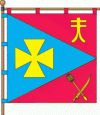Velyki Sorochyntsi (Velyki Sorochyntsi)
 |
 |
The population as of 2013 was estimated at 3,809, down from 4,231 in the 2001 Census.
The name of the village came either from the Slavic word Soroka (magpie) or Sorochka (shirt). There are many legends explaining the name of the village as the location of the Magpie's kingdom or of some magical shirt.
The earliest recorded mention of the settlement (sloboda) is in the 1620s. In 1646, the sloboda became the domain of a Polish Prince from the Wiśniowiecki family. By the end of the 17th and beginning of the 18th centuries, the sloboda was the location of a Cossack district (sotnia) government. Born here, the future Hetman of Zaporizhian Host Danylo Apostol in 1670 founded the Sorochynski Mikhailovsky Monastery. He went on to build the Ukrainian Baroque Church of the Transfiguration (Преображенська церква, translit. Preobrazhens'ka tsekrva) in 1732, also in Sorochyntsi, where he was buried two years later. Nikolai Gogol was later baptized in this same church.
Since the middle of the 18th century, the large Sorochyntsi Fair (Національний Сорочинський ярмарок, translit. Natsiolnal'nyi Sorochyns'kyi yarmarok, Сорочинcкaя яpмaркa, translit. Sorochinskaya yarmarka) has been held in Velyki Sorochyntsi. Recurring five times a year in the time of the Russian Empire, the fair is now held annually since its revival after a 40-year moratorium during Soviet rule. Since the Presidential Decree of August 18, 1999, the fair bears the status of the National trade fair. The fair is a large showcase for traditional handicrafts made by skilled craftsmen, including Reshetilivka embroidery, rugs, Opishnya ceramics, as well theatrical performers who re-enact scenes of village life from famous Ukrainian stories.
From 1925 to 1931 the city was called Neronovychi after the Ukrainian People's Secretary of Military Affairs, Yevhen Neronovych.
Map - Velyki Sorochyntsi (Velyki Sorochyntsi)
Map
Country - Ukraine
 |
 |
| Flag of Ukraine | |
During the Middle Ages, Ukraine was the site of early Slavic expansion and the area later became a key centre of East Slavic culture under the state of Kievan Rus', which emerged in the 9th century. The state eventually disintegrated into rival regional powers and was ultimately destroyed by the Mongol invasions of the 13th century. The area was then contested, divided, and ruled by a variety of external powers for the next 600 years, including the Polish–Lithuanian Commonwealth, the Austrian Empire, the Ottoman Empire, and the Tsardom of Russia. The Cossack Hetmanate emerged in central Ukraine in the 17th century, but was partitioned between Russia and Poland, and ultimately absorbed by the Russian Empire. Ukrainian nationalism developed, and following the Russian Revolution in 1917, the short-lived Ukrainian People's Republic was formed. The Bolsheviks consolidated control over much of the former empire and established the Ukrainian Soviet Socialist Republic, which became a constituent republic of the Soviet Union when it was formed in 1922. In the early 1930s, millions of Ukrainians died in the Holodomor, a man-made famine. During World War II, Ukraine was devastated by the German occupation.
Currency / Language
| ISO | Currency | Symbol | Significant figures |
|---|---|---|---|
| UAH | Ukrainian hryvnia | â‚´ | 2 |
| ISO | Language |
|---|---|
| HU | Hungarian language |
| PL | Polish language |
| RU | Russian language |
| UK | Ukrainian language |















